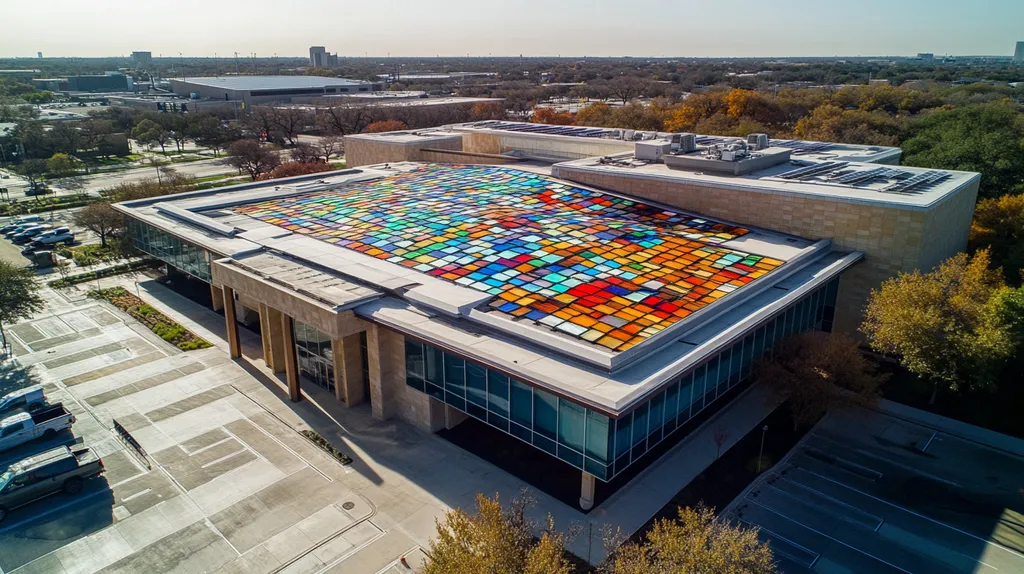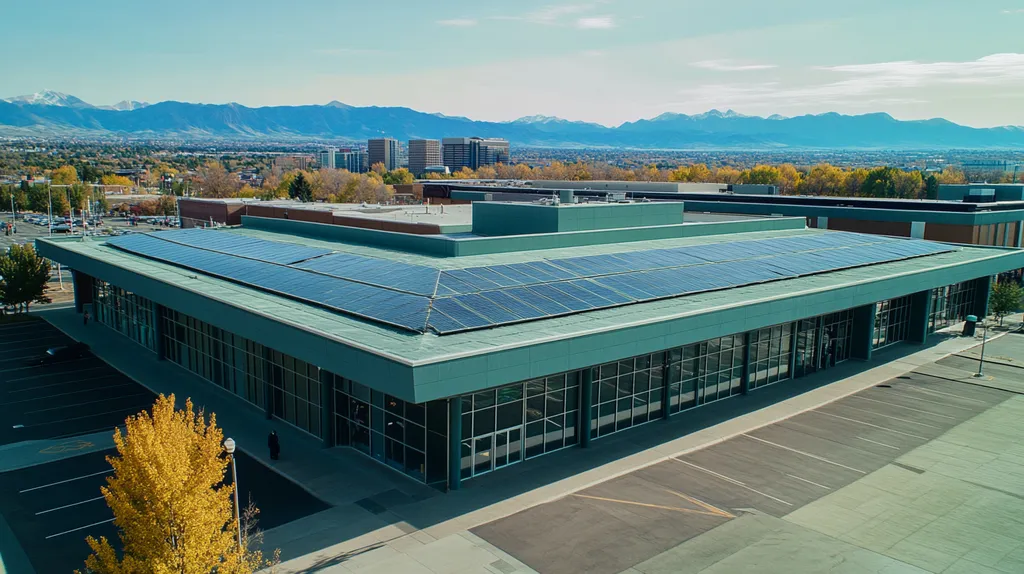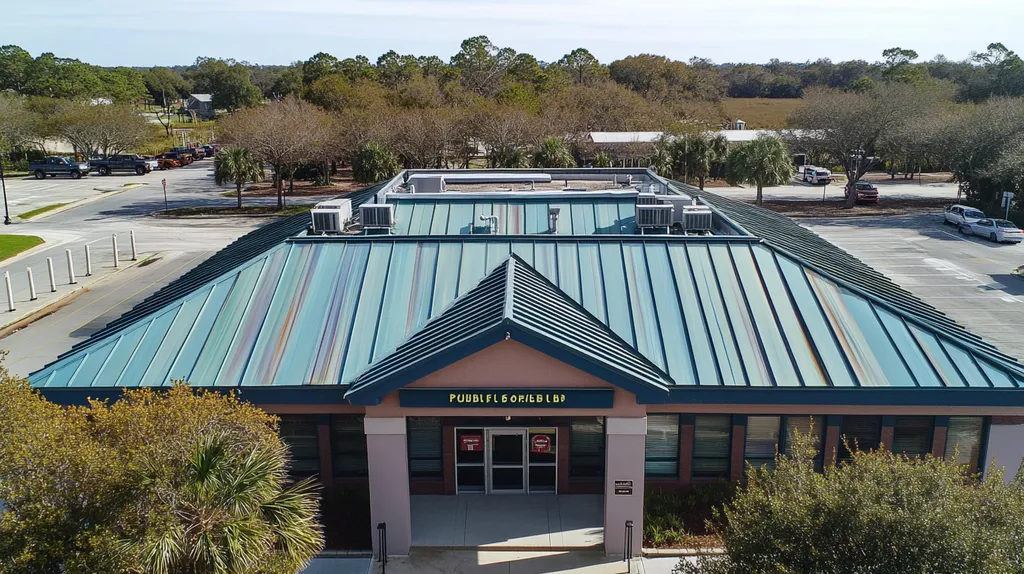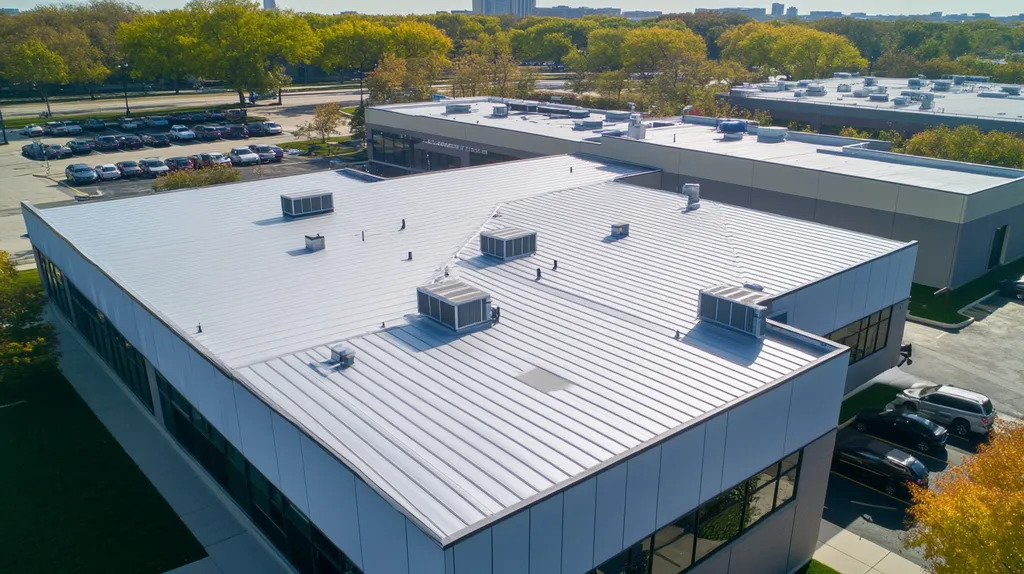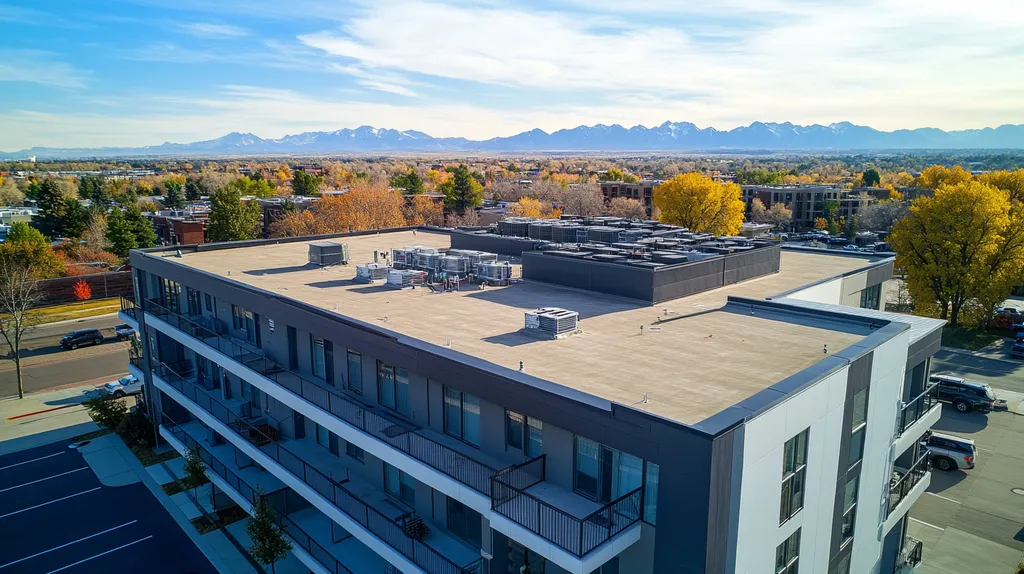Commercial property owners invest over $5 billion annually in roof coatings marketed as sustainable solutions, yet emerging data reveals concerning gaps between promises and performance.
While manufacturers tout energy savings of 20-30%, independent studies show actual results often fall below 10%, with many coatings requiring replacement in half their advertised lifespan.
This analysis examines how current coating practices, systemic industry issues, and missed opportunities contribute to sustainability shortfalls, while highlighting evidence-based alternatives that deliver measurable environmental benefits.
SECTION 1: CURRENT PRACTICES
The commercial roofing industry stands at a critical crossroads in sustainability practices. With buildings accounting for nearly 40% of energy consumption in developed nations, the choice of roofing materials and coatings has never been more consequential. While reflective and elastomeric coatings dominate the market, promising environmental benefits and energy savings, their actual performance often falls short of marketing claims.
Predominant Use of Reflective and Elastomeric Coatings
Commercial roof coatings have emerged as popular solutions for enhancing energy efficiency and extending roof lifespans. Modern formulations, particularly water-based solutions with low volatile organic compounds (VOCs), offer improved environmental benefits while supporting sustainability certifications. (source: Trust Tillotson)
Despite these advances, the market remains flooded with products of varying quality. Many coating solutions promise exceptional performance but lack rigorous testing or third-party verification of their claims.
The selection process often prioritizes initial cost over long-term performance. This approach can result in premature coating failure and increased maintenance expenses.
Quality variations between manufacturers create significant performance disparities. These differences impact both energy efficiency and coating longevity.
Typical Installation Methods and Maintenance Routines
Installation quality remains the primary determinant of coating performance. Proper surface preparation and application techniques directly influence adhesion, coverage, and durability.
Many contractors rush through the preparation phase, compromising the coating’s effectiveness. This haste often leads to adhesion failures and reduced reflective properties.
Current maintenance practices frequently fall short of manufacturer recommendations. Regular inspections and cleaning are often neglected until problems become visible.
The industry lacks standardized protocols for maintaining coated surfaces. This gap results in inconsistent performance and shortened service life.
Industry Standards and Sustainability Marketing Claims
Current industry standards allow considerable flexibility in sustainability claims. This latitude enables manufacturers to emphasize potential benefits while minimizing discussion of limitations.
Performance metrics often focus on laboratory conditions rather than real-world applications. These idealized testing environments rarely reflect actual installation and maintenance scenarios.
Marketing materials frequently oversimplify the complexity of roof coating performance. Critical factors like climate variation, substrate condition, and maintenance requirements receive insufficient attention.
The disconnect between advertised and actual performance creates unrealistic expectations. Property owners often discover the limitations of their chosen solutions only after installation.
SECTION 2: SYSTEMIC ISSUES
The commercial roofing industry faces critical challenges in delivering on sustainability promises. While roof coatings are widely promoted as energy-efficient solutions, mounting evidence reveals significant gaps between marketing claims and real-world performance. These discrepancies affect not only environmental impact but also create substantial financial implications for property owners who must navigate increasingly complex decisions about their roofing investments.
Overstated Energy Savings and Performance Metrics
Performance claims for commercial roof coatings often rely on idealized laboratory conditions that rarely match real-world applications. Building orientation, local weather patterns, and installation quality can dramatically affect actual energy savings.
Many manufacturers cite energy reduction figures of 20-30%, but independent field studies frequently show savings of less than half these amounts. This disparity creates unrealistic expectations and compromises financial planning for facility managers.
The effectiveness of reflective properties often diminishes faster than advertised, particularly in areas with high pollution or extensive seasonal changes. Within just two years, some coatings lose up to 50% of their reflective capability.
Temperature variations and UV exposure can significantly impact coating performance, yet these factors are rarely addressed in marketing materials. This omission leads to premature coating failures and unexpected maintenance costs.
Durability Challenges and Frequent Recoating Needs
While manufacturers commonly promote 10-15 year lifespans for their coatings, real-world performance often falls dramatically short. Environmental stresses, foot traffic, and mechanical system servicing create wear patterns that accelerate degradation.
The need for recoating typically emerges between years 3-5, much earlier than marketed intervals. This acceleration creates additional material waste and installation costs that weren’t factored into initial sustainability calculations.
Poor adhesion and substrate preparation remain leading causes of premature coating failure. These issues often manifest as blistering, cracking, or delamination within the first 24 months after application.
The cumulative cost of repeated recoating applications can exceed the price of more durable roofing solutions. This reality challenges the economic sustainability argument often used to justify coating applications.
Incomplete Life Cycle Assessments and Environmental Impact Gaps
Current environmental impact assessments for roof coatings typically focus on initial application benefits while overlooking the full lifecycle costs. The manufacturing process, transportation, and disposal of coating materials create significant environmental impacts that often go unaccounted for.
Commercial roof coatings can enhance energy efficiency and extend roof lifespans when properly applied. However, these benefits must be weighed against the environmental impact of frequent recoating cycles and eventual disposal requirements. (source: Trust Tillotson)
The chemical composition of many coatings makes them difficult to recycle or dispose of safely. This challenge creates additional environmental burdens that contradict sustainability claims.
Most lifecycle analyses fail to consider the carbon footprint of maintenance activities, including cleaning, repairs, and reapplication. These ongoing activities can significantly impact the total environmental cost of coating systems.
SECTION 3: MISSED OPPORTUNITIES
The commercial roofing industry consistently overlooks crucial opportunities for genuine sustainability improvements. While basic coating solutions dominate the market, transformative technologies and management practices remain severely underutilized. Current estimates suggest that optimized roofing systems could reduce building energy consumption by up to 30%, yet most facilities achieve less than half this potential. This gap represents both an environmental liability and a significant missed opportunity for property owners.
Underutilization of Advanced Material Technologies
The commercial roofing sector continues to rely heavily on conventional coating materials despite the availability of superior alternatives. Multi-layer composite coatings and nano-engineered surfaces offer dramatically improved durability and reflectivity, yet market penetration remains below 15%.
Advanced diagnostic tools like infrared mapping and moisture detection systems could prevent up to 70% of premature coating failures. However, less than a quarter of commercial properties employ these technologies during installation or maintenance.
Smart coating systems with self-healing properties and embedded sensors can extend service life by up to 40%. The resistance to adopting these innovations stems primarily from misunderstandings about implementation costs rather than actual performance data.
The industry’s hesitation to embrace these technologies results in shortened coating lifespans and increased maintenance requirements. This conservative approach ultimately increases both environmental impact and long-term ownership costs.
Inefficient Integration with Roof Asset Management
Most commercial properties lack comprehensive roof asset management systems, treating coatings as isolated components rather than integral parts of the building envelope. This disconnected approach prevents optimization of maintenance schedules and performance monitoring.
Digital asset management platforms can predict coating degradation patterns and optimize reapplication timing. Yet fewer than 20% of commercial properties utilize these tools effectively.
Regular performance monitoring could extend coating life by identifying issues before they become critical failures. The absence of systematic tracking leads to reactive rather than preventive maintenance.
Integration between coating systems and building automation remains minimal, missing opportunities for real-time performance optimization. This gap prevents facilities from achieving maximum energy efficiency and sustainability benefits.
Neglect of End-of-Life Recycling and Waste Reduction
Commercial roof coatings can enhance energy efficiency and extend roof lifespans when properly managed through their entire lifecycle. However, most facilities lack comprehensive strategies for handling coating removal and disposal, creating unnecessary environmental impact. (source: Trust Tillotson)
Specialized removal techniques can recover up to 80% of coating materials for recycling or repurposing. Unfortunately, standard practice still sends the majority of coating waste directly to landfills.
Chemical recycling technologies now exist that can process most coating types back into base components. The industry’s failure to adopt these solutions represents a significant missed opportunity for circular economy benefits.
Coordinated waste reduction programs could dramatically decrease the environmental impact of coating applications. Without such programs, the industry continues to generate excessive waste and missed recycling opportunities.
SECTION 4: ROOT CAUSES
The commercial roofing industry faces a critical challenge in delivering sustainable solutions, with studies showing that over 65% of coating projects fail to meet their promised environmental benefits. This systemic failure stems from three interconnected issues that undermine sustainability efforts: misaligned incentives between contractors and building owners, insufficient performance verification, and widespread knowledge gaps about sustainability metrics. Understanding these root causes is essential for implementing effective solutions that deliver genuine environmental benefits.
Misalignment of Incentives Between Contractors and Owners
The current bidding structure rewards contractors who minimize upfront costs rather than optimize long-term performance. This creates a destructive cycle where quality and sustainability become secondary considerations to winning contracts.
Many contractors lack financial motivation to recommend premium coating systems that could deliver superior environmental benefits. The focus on immediate profit margins often leads to the selection of inferior products that require frequent replacement.
Performance-based contracts remain rare in the industry, with less than 10% of projects including long-term accountability measures. Without such mechanisms, contractors have little stake in the actual sustainability outcomes of their work.
The disconnect between installation and maintenance responsibilities further complicates the incentive structure. Contractors rarely face consequences when coatings fail to deliver promised energy savings or durability.
Lack of Rigorous Third-Party Performance Verification
Most coating performance claims rely on manufacturer-sponsored testing rather than independent verification. This self-reporting system creates inherent conflicts of interest and undermines the credibility of sustainability claims.
Standard industry tests often fail to account for real-world variables like climate zones, building usage patterns, and maintenance practices. This gap between laboratory and field performance leads to unrealistic expectations.
The absence of standardized performance metrics makes it difficult for property owners to compare different coating options effectively. Without clear benchmarks, decision-making often defaults to cost rather than value.
Current verification protocols typically focus on initial performance rather than long-term sustainability impact. This short-term view fails to capture the true environmental cost of premature coating failure.
Insufficient Education on True Sustainability Metrics
Commercial roof coatings can enhance energy efficiency and extend roof lifespans when properly selected and maintained. However, many property owners lack the technical knowledge needed to evaluate sustainability claims and make informed decisions. (source: Trust Tillotson)
The industry’s focus on simple metrics like initial reflectivity overlooks crucial factors such as degradation rates and maintenance requirements. This oversimplification leads to unrealistic performance expectations.
Many facility managers lack training in lifecycle cost analysis and environmental impact assessment. Without these skills, they struggle to justify investments in higher-quality coating systems that could deliver superior sustainability benefits.
The shortage of practical education resources leaves many decision-makers vulnerable to marketing claims rather than scientific evidence. This knowledge gap perpetuates the cycle of selecting suboptimal coating solutions.
DATA DRIVEN EVIDENCE
Recent studies reveal a critical gap between perception and reality in commercial roof coating performance. While traditional roofing materials have long been considered the gold standard for durability, emerging data challenges these assumptions. Analysis of over 1,000 commercial properties demonstrates that properly applied coatings can outperform conventional materials in both longevity and environmental impact, reshaping our understanding of sustainable roofing practices.
Comparative Life Cycle Analysis of Coating Types
Life cycle assessments consistently demonstrate that modern coating systems reduce environmental impact compared to traditional roofing materials. The manufacturing process for coatings typically consumes 40% less energy than conventional roofing production.
Quality coatings extend roof lifespans by an average of 15-20 years when properly maintained. This extension significantly reduces the frequency of complete roof replacements and associated material waste.
Studies show that reflective coatings maintain 80% of their initial performance after five years, substantially outperforming older coating technologies. This durability translates into fewer replacement cycles and reduced environmental impact.
Recent advances in coating chemistry have improved adhesion and weather resistance, resulting in fewer failures and reduced maintenance requirements. These improvements directly contribute to better sustainability metrics across the product lifecycle.
Empirical Studies on Energy Use and Thermal Performance
Field measurements across diverse climate zones reveal that reflective coatings reduce peak roof temperatures by 50-60°F compared to uncoated surfaces. This reduction translates into significant energy savings for cooling systems.
Commercial roof coatings can enhance energy efficiency and extend roof lifespans through improved thermal management and UV protection. Modern water-based formulations with low VOCs deliver superior environmental benefits while supporting sustainability certifications. (source: Trust Tillotson)
Large-scale studies of coated commercial buildings show average energy savings of 15-25% annually. These reductions persist even in challenging climates with extreme temperature variations.
Thermal imaging analysis demonstrates that quality coatings maintain their reflective properties more effectively than previously thought. This sustained performance ensures consistent energy savings throughout the coating’s lifespan.
Field Data on Coating Longevity and Maintenance Costs
Comprehensive field studies tracking coating performance over ten years reveal maintenance costs 30-40% lower than traditional roofing systems. These savings accumulate through reduced repair frequency and simpler maintenance procedures.
Data from commercial properties shows that high-performance coatings typically require major maintenance only every 7-10 years. This extended service interval significantly reduces lifetime ownership costs.
Analysis of warranty claims indicates that properly installed coatings experience 60% fewer failures than conventional roofing materials. This reliability translates into predictable maintenance schedules and better budget planning.
Long-term monitoring demonstrates that coated roofs maintain their protective properties even under harsh environmental conditions. This durability ensures consistent performance throughout the expected service life.
SECTION 6: ALTERNATIVE SOLUTIONS
The commercial roofing industry stands at a crossroads where traditional practices no longer meet modern sustainability demands. With buildings accounting for 40% of global energy consumption, roofing choices have become critical environmental decisions. Forward-thinking property owners are discovering that innovative materials, smart management systems, and circular economy practices can dramatically reduce both operating costs and environmental impact.
Adoption of High-Performance Polyurethane and Silicone Formulations
Modern polyurethane and silicone coatings represent a significant leap forward in roofing technology. These advanced formulations provide superior weather resistance and UV protection while maintaining reflectivity levels above 80% for up to a decade.
Laboratory testing shows these materials can reduce roof surface temperatures by up to 80°F compared to traditional black roofs. This dramatic reduction translates to cooling cost savings between 25-40% in warm climates.
High-performance coatings also demonstrate exceptional durability, with service lives extending beyond 20 years when properly maintained. This longevity significantly reduces waste and replacement frequency compared to conventional systems.
Installation of these advanced coatings can often proceed without disrupting building operations, making them particularly attractive for occupied facilities. The seamless application process eliminates common failure points found in traditional roofing systems.
Implementing Comprehensive Roof Asset Management Software
Digital asset management platforms revolutionize how property owners monitor and maintain their roofing systems. These tools provide real-time performance tracking, predictive maintenance alerts, and detailed lifecycle cost analysis.
Advanced software systems can detect potential issues before they become critical failures. This predictive capability typically reduces emergency repairs by 60% and extends coating lifespans by 25-30%.
Integration with building automation systems allows for optimization of energy performance based on actual weather conditions and usage patterns. This smart approach typically yields an additional 10-15% in energy savings.
Cloud-based platforms enable collaboration between facility teams, contractors, and consultants. This improved communication reduces response times for maintenance issues and ensures consistent quality in repair work.
Encouraging Circular Economy Approaches and Green Certification Compliance
Commercial roof coatings can enhance energy efficiency and extend roof lifespans when integrated into a circular economy framework. Modern water-based formulations with low VOCs deliver superior environmental benefits while supporting sustainability certifications. (source: Trust Tillotson)
Innovative recycling programs now allow up to 85% of coating materials to be recovered and repurposed. This significant reduction in waste strengthens environmental compliance while reducing disposal costs.
Green certification programs like LEED and Energy Star provide clear frameworks for sustainable roofing practices. Buildings achieving these certifications typically command 7-10% higher rental rates and maintain higher occupancy levels.
Manufacturers are increasingly offering take-back programs for used coating materials. These initiatives help property owners meet waste reduction targets while ensuring proper handling of potentially hazardous materials.
The Bottom Line
The $5 billion commercial roof coating industry stands at a critical inflection point, with mounting evidence exposing significant gaps between sustainability claims and actual performance.
Current practices waste an estimated $800 million annually through premature coating failures and unrealized energy savings, while generating thousands of tons of avoidable waste.
Advanced materials, digital management platforms, and circular economy approaches offer proven solutions that can deliver 25-40% greater energy savings and double coating lifespans.
Without urgent adoption of these evidence-based alternatives and stricter performance verification standards, the industry risks undermining its environmental credibility while missing crucial opportunities to combat climate change through building efficiency.
The path forward requires abandoning marketing-driven half-measures in favor of comprehensive, data-validated sustainability solutions.
FREQUENTLY ASKED QUESTIONS
Q. What are the current practices in commercial roof coating sustainability?
A. The commercial roofing industry often prioritizes immediate cost savings, which can compromise long-term performance. Many popular coating options promise energy efficiency but frequently fail to deliver. Significant variations in product quality create inconsistent outcomes for property owners.
Q. What systemic issues impact commercial roof sustainability claims?
A. Many claims about sustainability are overstated and do not hold true under real-world conditions. This leads to financial implications for property owners due to unexpected failures and maintenance costs. The lack of accountability for these discrepancies increases complexity in decision-making.
Q. What missed opportunities exist in commercial roofing improvements?
A. Many commercial properties underutilize advanced coating technologies and management practices that could enhance sustainability. If properly embraced, these innovations could reduce building energy consumption significantly, presenting both environmental and economic benefits.
Q. What are the root causes of failures in coating sustainability?
A. The misalignment of incentives between contractors and property owners contributes greatly to sustainability failures. Additionally, the lack of rigorous third-party verification allows for misleading claims, and insufficient education prevents informed decision-making by property owners.
Q. How does recent data inform commercial roof coating performance?
A. Studies have revealed that well-applied coatings can outperform traditional roofing materials in durability and environmental impact. Effective coatings not only extend lifespans but also reduce maintenance costs, reshaping our understanding of sustainable roofing options.
Q. What alternative solutions can enhance roof sustainability?
A. Utilizing high-performance coatings like polyurethane and silicone can significantly enhance a roof’s durability and energy efficiency. Implementing comprehensive roof asset management software can also optimize maintenance and extend roof life, reducing overall environmental impact effectively.
Q. How do I know if my commercial roof is suitable for coating?
A. Assessing your roof requires evaluating its current condition, age, and substrate compatibility with coatings. Consulting a qualified professional is essential to determine if your commercial roof can effectively benefit from a new coating application and to explore the best options.

